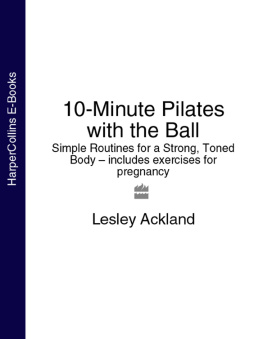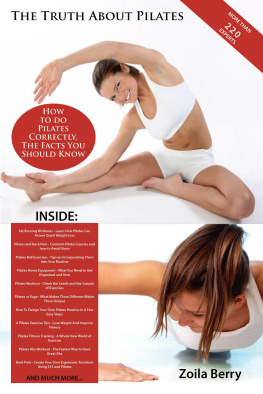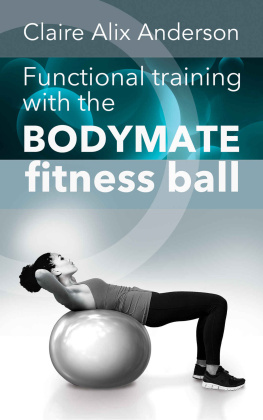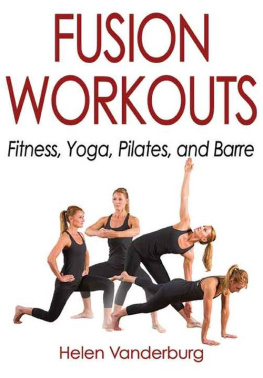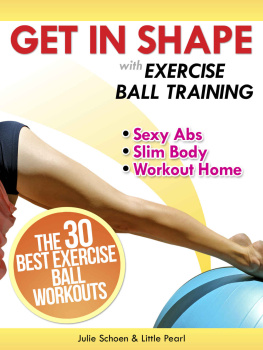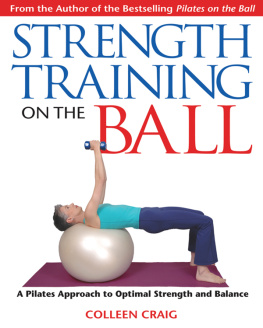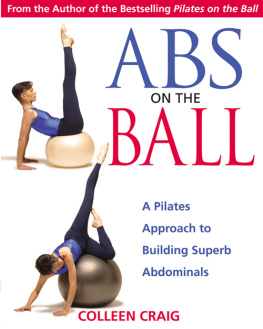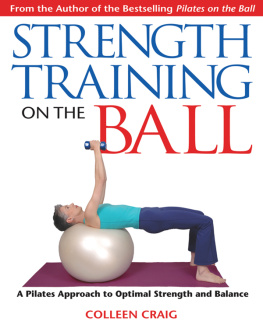
101 WAYS TO WORK OUT ON THE BALL
SCULPT YOUR IDEAL BODY WITH PILATES, YOGA, AND MORE
Elizabeth Gillies

For my Dad, Francis D. Gillies, Jr., in loving memory.
His passion for books was truly inspiring.

Contents

INTRODUCTION Whats The Big Buzz About the Ball?
These days, if you look around gyms, physical therapy clinics, and Pilates studios, youll most likely see racks of stability balls in various sizes and shapes. Likewise, if you exercise at home, youve probably found the ball to be one of your favorite pieces of equipment.
Thats because the stability ball delivers profound results and is easy to use, while also offering a good challenge to both beginners and advanced exercisers. People are completely changing their workout regimens with this user-friendly propthey do their ab workouts on the ball, lift weights on the ball, and practice yoga and Pilates on the ball!
The balls effectiveness stems from its ability to naturally establish an awareness of your bodys imbalances, thus helping to improve and develop functionality and agility. To translate that to lay terms: because you have to work to keep your balance while youre on the ball, you end up strengthening weak muscles as well as all of your core muscles.
In other words, lets say you do a push-up while on the ball; you not only strengthen your triceps, pectorals, and back muscles as you would with a traditional push-up, but you also add in the extra stabilizing work, so your abs and lower back muscles, as well as all of your smaller supporting muscles get a workout.
But theres more! Anytime you change the way you perform an exercise, you force your muscles to work harder than theyre used to. So, once you put that push-up on the ball, your stronger muscles have to work harder than they usually do and your weaker muscles have to pull more of their own weight (if youll forgive the pun).
As you can see, ball work really cant be beat for both fun and effectiveness.
This is why my clients who work with the ball are hooked! They have reshaped their bodies, look and feel energized, and have dramatically improved their posture. Clients love the ball so much, many of them have begun to use one as the chair at their desks!
The History of the Ball
The Swiss, or stability, ball was originally introduced as the gymnastic ball by Dr. Susanne Klien-Vogelbach, a doctor in Switzerland. Dr. Klien-Vogelbach created the ball in the 1960s for use in physical therapy to treat orthopedic and neurological disorders. Doctors had children with cerebral palsy and inefficient motor skill development use the ball to help neuro-muscular stimulation. When someone with poor motor skills uses the ball, their brain pathways are re-patterned and they are able to improve the way their body moves.
Swiss ball work began show up on the US physical therapy scene through a protg of Klien-Vogelbachs. In the 70s and 80s, the ball began to be used as part of the rehabilitation process for people with spinal injuries.
The first balls were manufactured by an Italian toy manufacturer named Aquilino Cosani, whose company Gymnic remains the leader in ball making. The Gymnic balls became highly acclaimed for helping to develop motor-sensory skills in premature babies and children with traumatic motor-skill retardation. Observers noted that the colorful balls, with their circular shape and dynamic surface, were inviting to the senses while, at the same time, the exercises being done with them produced very positive outcomes.
While the stability ball has always been one of best ways to prevent and rehabilitate injuries, its more likely that you have other goals, such as the long, lean body that comes with Pilates, weight-training, yoga, and other resistance exercise. Fortunately, the ball adds challenge and fun to those exercisesand thats why were all here! The unstable surface of the ball is the easiest and most foolproof way to become aware of postural deficiencies and then to work to correct them.
Even though ball work was first developed as a form of physical therapy and not as a form of exercise for healthy people, the ball is a natural in the gym! It blends the therapeutic values of stability and balancing skills with conventional exercises while also teaching the importance of using core muscles actively.
Your core, or center of gravity in your trunk, is made up of your abs, back, and buttocks. The muscles within these body sections need to function together at all timeswhether youre just going about your daily activities or youre engaged in an athletic sport or exercise.
For example, on the ball, even if you are doing an exercise focusing on the muscles of your arm, such as doing a biceps curl, your core muscles will still have to support your upper body to maintain good posture and create good muscle coordination as you perform the exercise.
This mindful method develops better-looking, symmetrical, stronger, longer, leaner muscles. This therapeutic approach to exercise is especially important to combat chronic back pain and to avoid unnecessary surgery. The Communication Age requires us to sit and bend forward at computers and driving in cars, in addition to more natural physical requirements, such as lifting children and groceries. And we rarely spend enough time stretching and relaxing our muscles (or strengthening those same muscles in beneficial ways).
The balls therapeutic benefits come from the shape and unstable surface of the ball in relationship to the natural curves in the spine, which challenges your balance and requires your brain to improve its ability to coordinate your muscles, encouraging more muscles to work together in synergy front to back. The shape of the ball makes it easy to open up tightened rib cages, which improves your breathing and restores elasticity and life to your spine.
Many fitness professionals today use the stability ball in lieu of a weight bench to ensure proper form and to recruit the small stabilizing muscles that provide joint support. Working with the stability ball also conditions the mind as well as the body, allowing you to become aware of how you perform any movement, whether dancing or picking up a baby or playing football. This promotes healthy movement, agility, and injury prevention.
Were fortunate to see those brightly colored balls in all sizes gaining popularity in the fitness world. Many well-educated trainers, some of whom also work in the physical therapy field, continue to develop new ways to incorporate the ball into their repertoire.
Pilates and Ball Work
This is going to sound almost too obvious, but bear with me. If you cant balance on the ball, then you cant really do any sort of exercise properly. Being able to balance means the most important muscles of your bodyyour core musclesare strong and capable.
Pilates, a form of exercise developed by Joseph Pilates, will create a strong core. The progressive lessons of Pilates teach postural awareness and correct muscular imbalances. You cannot do ball work without understanding the basics of Pilates.
Next page

